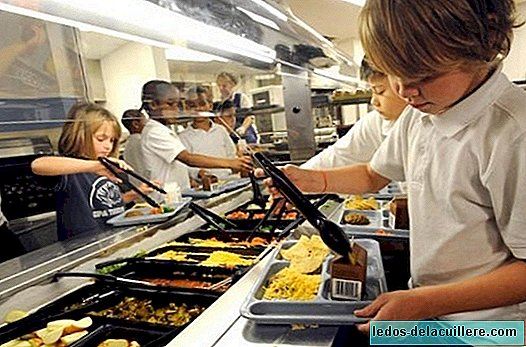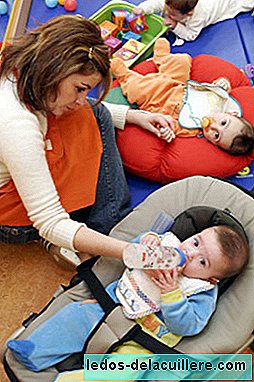The children begin to stay to eat in the school and they will do it during the rest of the course. Nine months a year, five meals a week: How should school canteens be? What should we expect parents from this space?
Basically a school canteen should offer the same menu as at home, with all the characteristics that make food a healthy habit. That is a balanced menu, varied, adapted to the needs of each age ... But also something that is sometimes forgotten (if not almost always): that the mealtime is pleasant, that there is no hurry, that you can talk ... And is that the school canteen is a complementary educational service offered by the centers.
Let's keep in mind that proper food and nutrition is necessary during school age, which will allow children to grow up healthy. And, at the same time, here they have to acquire a complementary nutritional education that we give them at home, as a family. Because in childhood when they shape the eating habits that will be maintained throughout life.
Menus in the school canteen
The best way to achieve an adequate nutritional status is to incorporate a wide variety of foods into our daily diet, incorporating foods from different groups of the pyramid into the meal. Let us take into account that the midday meal supposes the intake of 30-35% of the daily energy contribution, with a considerable volume of nutrients.
Malnutrition, both due to deficit (malnutrition) or excess (overweight and obesity), can have detrimental results in the short and long term, so school menus must be adapted.
According to "Healthy eating guide" of the Spanish Society of Community Nutrition (SENC), the structure and planning of the menus in the school should be: sufficient, varied, adapted to the characteristics and needs of the dining rooms, and also pleasant.
The food can be composed of:
- Rice, pasta, potatoes or legumes: a serving.
- Salad or vegetables: a serving or side dish.
- Meat or fish or egg alternately: a serving.
- Bread: one piece.
- Fruit: one piece (and we would reach five servings of fruit and vegetables daily for the rest of the day).
- Water, which should be the only drink at meals.
In addition, it is recommended enhance the variety and indigenous gastronomic identity of each area, and the cultural aspects of food, as well as adapting preparations to seasonal foods and the time of year.
Regarding the frequency of food consumption, the SENC recommends, approximately, the following:
In first courses: 1 time legume, 1 time vegetable (raw, cooked or pureed), 1 time pasta, 1 time rice, 1 time potatoes.
In the second dishes: 1 time fish, 1 time egg and the rest, different types of meat, giving priority in the garnishes to fresh vegetable preparations.
It is advisable to avoid the first and second plate combinations of difficult acceptance (first vegetable and second fish) and adapt the first and second plate combinations so that they are neither too light nor too dense.
Four of the five desserts of the week should be based on fruit, preferably fresh, reserving a day for dairy desserts (yogurt, curd, fresh cheese, ice cream) or sweet desserts.
The dining room should have gluten-free menus and suitable for different food allergies or diets. And finally, at home, remember that providing a variety of flavors, smells, shapes and consistencies arouses children's interest and stimulates their appetite.

The dining room as an educational space
In addition to providing a quality meal both nutritionally and under hygienic criteria, we must promote proper eating and behavioral hygiene habits, as well as the social and convivial aspects of the meals. Students can be educated in respect and coexistence, in responsibility ... which contributes to the development of their personality.
Nutrition education requires parents and teachers patience, dedication and respect for the characteristics of children, since they will not always be with the best appetites or will be reluctant to take certain foods.
Some schools are already promoting this way of understanding the time of the dining room, without forbidding children to speak (maintaining an adequate tone) and giving them more time if necessary ... In certain communities the minimum duration of meals for each shift is set at 30 minutes And it is not good (or like) to eat in a hurry ...
The little ones will sometimes need help if the food is not chopped (meat, a fruit ...) and in these cases it would not only be the task of the monitors: older students could help them in a very rich collaboration and interaction for both ages.
Sometimes special gastronomic days are held, dedicated to other countries and cultures, which not only diversifies the taste but also teaches them to accept and respect the "different", often with a student body that is an example of multiculturalism.
It is also sought that the physical space of the dining room is pleasant, allowing you to enjoy the moment of food in a relaxed atmosphere. A well-lit, ventilated space that is at a good temperature, that includes educational messages ...
After all, in addition to fulfilling a basic function of food and nutrition, the school canteen plays an outstanding social and educational function, so it cannot be a place simply where students are fed. Do not forget that this educational aspect does not end in school but begins in the family. We will have to provide the children with a healthy breakfast, as well as lunch, snack, dinner ...
Well, maybe this is an ideal, utopian dining room, but we love to dream and give voice to those characteristics that school canteens should have, since our children will make most of the meals there throughout the year. Many days, many hours, many foods ... It is not a trivial matter!
Photos | iStock
In Babies and more | The ideal menu in the school canteen, "Mom, I miss you in the dining room"












